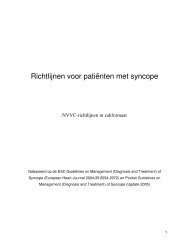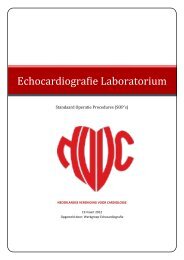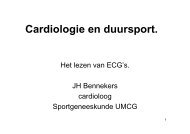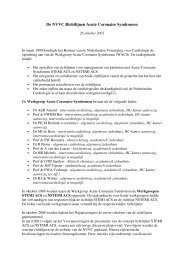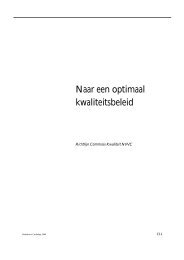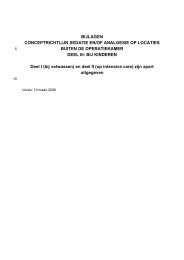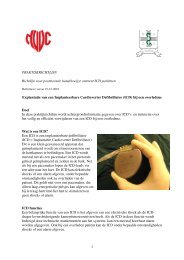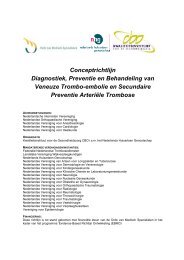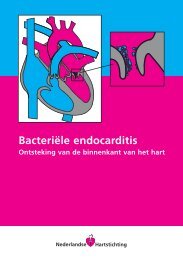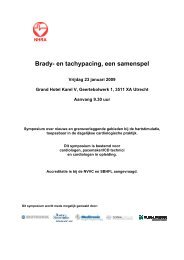Inhoudsopgave richtlijn Beroerte concept 12-3-07 - NVVC
Inhoudsopgave richtlijn Beroerte concept 12-3-07 - NVVC
Inhoudsopgave richtlijn Beroerte concept 12-3-07 - NVVC
Create successful ePaper yourself
Turn your PDF publications into a flip-book with our unique Google optimized e-Paper software.
Niveau 2<br />
Het is aannemelijk dat MR en CTP vergelijkbaar penumbra/infarct mismatch<br />
kunnen afbeelden<br />
B Wintermark 2002, Bisdas 2004, Schramm 2004, Wintermark 2006<br />
Overige overwegingen<br />
MRI is beter dan CT zonder intraveneus contrast (NCT) voor het detecteren van acute<br />
ischemie. CT is echter overal in Nederland 24 uur per dag beschikbaar en zal voorlopig<br />
waarschijnlijk het meest gebruikte onderzoek voor acute beroerte blijven. Bovendien is CT<br />
geschikter voor ernstig zieke en onrustige patiënten. Weinig klinieken in Nederland hebben<br />
voldoende ervaring met MR perfusie of CT perfusie beeldvorming.<br />
De klinische betekenis van de penumbra/infarct mismatch is nog geheel niet duidelijk.<br />
Aanbeveling(en)<br />
Ondanks het feit dat MR met DWI beter is dan CT zonder intraveneus contrast voor het<br />
detecteren van acute ischemie, is een CT voldoende om een bloeding of andere oorzaak<br />
uit te sluiten ten behoeve van intraveneuze trombolyse binnen drie uur.<br />
Vroege ischemische veranderingen op non-contrast CT hoeven geen contra-indicatie te<br />
vormen voor trombolysebehandeling binnen 3 uur na het ontstaan van symptomen.<br />
Het routinematig meten van de penumbra/infarct mismatch wordt niet aanbevolen, omdat<br />
de klinische betekenis hiervan nog niet duidelijk is.<br />
Literatuur<br />
- Adams HP Jr, Adams RJ, Brott T, del Zoppo GJ, Furlan A, Goldstein LB, et al. Guidelines for<br />
the early management of patients with ischemic stroke: a scientific statement from the Stroke<br />
Council of the American Heart Association/American Stroke Association. Stroke 2003;34:1056-<br />
1083.<br />
- Adams H, Adams R, Del Zoppo G, Goldstein LB; Stroke Council of the American Heart<br />
Association; American Stroke Association. Guidelines for the early management of patients<br />
with ischemic stroke: 2005 guidelines update a scientific statement from the Stroke Council of<br />
the American Heart Association/American Stroke Association. Stroke 2005;36:916-923.<br />
- Bandera E, Botteri M, Minelli C, Sutton A, Abrams KR, Latronico N. Cerebral blood flow<br />
threshold of ischemic penumbra and infarct core in acute ischemic stroke: a systematic review.<br />
Stroke 2006;37:1334-1339.<br />
- Bisdas S, Donnerstag F, Ahl B, Bohrer I, Weissenborn K, Becker H. Comparison of perfusion<br />
computed tomography with diffusion-weighted magnetic resonance imaging in hyperacute<br />
ischemic stroke. J Comput Assist Tomogr 2004;28:747-755.<br />
- Chalela JA, Kidwell CS, Nentwich LM, Luby M, Butman JA, Demchuk AM, et al. Magnetic<br />
resonance imaging and computed tomography in emergency assessment of patients with<br />
suspected acute stroke: a prospective comparison. Lancet 20<strong>07</strong>;369:293-298.<br />
- Cornu C, Boutitie F, Candelise L, Boissel JP, Donnan GA, Hommel M, et al. Streptokinase in<br />
acute ischemic stroke: an individual patient meta-analysis. The thrombolysis in acute stroke<br />
pooling project. Stroke 2000;31:1555-1560.<br />
Richtlijn <strong>Beroerte</strong>, 2008<br />
22 Kwaliteitsinstituut voor de Gezondheidszorg CBO



